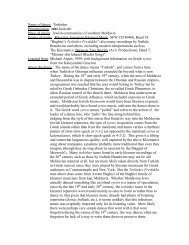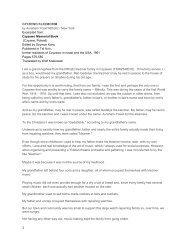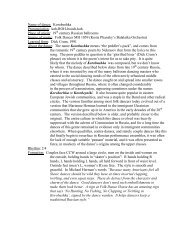PAS D'ESPAGNE - Helen's Yiddish Dance Page
PAS D'ESPAGNE - Helen's Yiddish Dance Page
PAS D'ESPAGNE - Helen's Yiddish Dance Page
Create successful ePaper yourself
Turn your PDF publications into a flip-book with our unique Google optimized e-Paper software.
<strong>PAS</strong> D’ESPAGNE<br />
From: Barthélemy G. Bottallo, Guide du bon danseur, par le professeur B.-G.<br />
Bottallo[The Good <strong>Dance</strong>r’s Guide, by Professor B.G. Bottallo]. Paris: Imp. Jouve & cie,<br />
1912, p. 114. Translated and recast in conventional American terminology by Dick Crum.<br />
Although the name of this dance might lead one to believe that it is Spanish, it is actually<br />
Russian, and is very popular in that country, though it is not danced exactly the same way<br />
as here in France, where it is performed according to the French version promulgated by<br />
the International Academy of Masters and Teachers of <strong>Dance</strong>, Deportment and<br />
Grooming. I shall give the Russian version in my next publication; for now I shall present<br />
only the French variant. I wish to warn my readers that preservation of this dance’s<br />
original character requires great agility and full mastery of its movements.<br />
Gentleman takes lady’s left hand in his right hand and they position themselves almost<br />
face-to-face, but slightly angled and oriented forward in line of direction<br />
(counterclockwise around the floor). Every figure in this dance begins with gentleman’s<br />
left foot, lady’s right foot.<br />
MOTIF 1 [4 meas of ¾ time]<br />
ct 1 Stamp onto Lft forward (in line of direction) about 50 centimeters.<br />
ct 2 Immediately bring Rft in air forward of Lft.<br />
ct 3 Hop on L toe, pivoting a ¼ turn L, bringing R arm forward straight.<br />
The Rft is in the air during cts 2 and 3. At this point partners are back-to back, arms<br />
extended, and they remain in this position for the 9 counts that follow.<br />
ct 4 Glide R toe forward (in line of direction) a few centimeters and step onto R toe.<br />
ct 5 Close L toe to R heel without taking weight on L toe, rising slightly on R toe.<br />
ct 6 Lower R heel to floor, maintaining weight on Rft.<br />
ct 7 Glide L toe backwards (against line of direction) a large distance and step onto L<br />
toe.<br />
cts 8-9 Close R toe to Lft, taking weight on Rft.<br />
ct 10 Repeat the movements of ct 7.<br />
cts 11-12 Close R toe to Lft without taking weight on Rft.<br />
MOTIF 2 [4 meas of ¾ time] Repeat the entire figure beginning with Rft.<br />
ct 1 Stamp onto Rft forward (in line of direction).<br />
ct 2 Immediately bring Lft in air forward of Rft.<br />
ct 3 Hop on R toe, pivoting a ¼ turn R.<br />
From this point partners are face-to-face for the 9 counts that follow.<br />
ct 4 Glide L toe forward (in line of direction) a few centimeters and step onto L toe.<br />
ct 5 Close R toe to L heel without taking weight on R toe, rising slightly on L toe.<br />
ct 6 Lower L heel to floor, maintaining weight on Lft.<br />
ct 7 Glide R toe backwards (against line of direction) and step onto R toe, the arms<br />
rounded.<br />
cts 8-9 Close L toe to R heel, taking weight on Lft.<br />
cts 10-11-12 Repeat the movements of cts 7-8-9, without taking weight on Lft.
MOTIF 3 [2 meas of ¾ time]<br />
Gentleman and lady join R hands, facing each other.<br />
ct 1 Glide Lft sideward L in line of direction, taking weight on it.<br />
cts 2-3 Bring R toe, with leg straight and heel raised, to L heel, and lower R heel, taking<br />
weight on it.<br />
cts 4-5-6 Repeat the movements of cts 1-2-3, again taking weight on Rft.<br />
MOTIF 4 [2 meas of ¾ time]<br />
With R hands still joined, gentleman and lady cross over and change places using two<br />
“American Boston” steps,* he starting the first with Lft, and passing R shoulders. The<br />
last Boston step must be “rounded out” by pivoting a ¼ turn to R to ensure partners are<br />
face-to-face.<br />
MOTIF 5 [2 meas of ¾ time]<br />
Gentleman and lady release hands and do two balance steps in place during the following<br />
6 counts.<br />
ct 1 Stamp onto Lft sideward L.<br />
ct 2 Step with R toe across in front of Lft, knee straight, and rising on both toes; at the<br />
same time gentleman raises curved L arm in air and curves his R arm across his chest.<br />
ct 3 Lower heels and take weight on Lft.<br />
cts 4-5-6 Repeat movements of cts 1-2-3 to the R with opposite footwork and<br />
reversing arm positions.<br />
During the above balance steps lady grasps both sides of her skirt and holds them out,<br />
elbows flexed.<br />
MOTIF 6 [2 meas of ¾ time]<br />
Gentleman and lady return to home positions with two Boston steps, [he] beginning with<br />
Lft, passing R shoulders.<br />
Gentleman takes lady’s L hand in his R hand to resume the dance from the beginning,<br />
doing it four more times unless the orchestra plays it longer.<br />
The lady does the same counts and movements as the gentleman, but with opposite<br />
footwork.<br />
_______________________________________<br />
* American Boston step: ct 1 Step fwd on Lft; ct 2 Rise slightly on L toe; ct 3 Lower L<br />
heel to floor. Repeat with Rft, etc. Cues: “Lft-up-down,” “Rft-up-down,” etc.
PADESPAN’<br />
From: I.I. Ivanov, Novejshij Samouchitel’ Bal’nyx Tancev [The Latest Ballroom Self-<br />
Tutor]. Moscow: P.V. Bel’cov, 1908, p. 42. Translated by Dick Crum. [Note: The<br />
original Russian text of this description is very poorly written, with run-on sentences and<br />
with many critical moves omitted or unclear. The author’s intent may have been simply to<br />
provide “reminder” notes for persons already familiar with the dance.]<br />
Gentleman and lady position themselves face-to-face, he takes her hand in his R hand,<br />
takes a side step with Lft, hops on it, at the same time turning L and kicking Rft forward,<br />
maintaining weight on Lft. Then he takes one step forward with Rft, after which he takes<br />
two steps back, sliding R toe to close after each. Then gentleman and lady change places,<br />
not releasing joined hands. Both take a step forward with Rft, hop on it, kicking Lft<br />
forward and taking one step with Lft; in order to be face-to-face they release joined<br />
hands, remaining in opposite places, and take two step-draws sideward R and L, then<br />
joining R hands they return to home positions with the same step-draws. Then he takes<br />
her L hand in his R hand and they begin the dance all over again.
Pa d’Espan’ (Pas d’Espagne)<br />
From: A.D. Tixomirov, Samouchitel’ modnyx bal’nyx i xarakternyx tancev [Self-Tutor<br />
of fashionable ballroom and character dances] by A.D. Tixomirov, Artist of the Imperial<br />
Theatres. Moscow: S. Kashincev, Bookseller, 1901, p. 61. Translation by Mike Aylward,<br />
edited and recast in conventional American dance terminology by Dick Crum.<br />
These days the Pas d’Espagne is the most graceful and interesting of all ballroom dances.<br />
As its name indicates, the Pas d’Espagne is a Spanish dance.<br />
It is composed of figures of the Cachucha and the Bolero, adapted for performance in the<br />
ballroom, and may be danced by any number of couples.<br />
In view of its Spanish origins, this dance requires a special manner of performance; free<br />
hand is on hip and the trunk is slightly inclined toward the opposite direction to that in<br />
which the dance is moving.<br />
Gentleman stands opposite lady, feet in 3 rd position, and takes her L hand in his R hand<br />
(see Fig. 34).<br />
Then he steps slightly forward with Lft [ct 1] and pivots on it [ct 3], bringing Rft forward<br />
and stepping onto it [ct 4], [closing Lft to Rft without taking weight [ct 6]? Though not<br />
stated, this close is implied by the general style of the dance], at the same time bringing<br />
hands forward (see Fig. 35 [Note: Fig. 35 shows partners not fully back-to-back as in<br />
other descriptions of the dance]).<br />
From this position gentleman steps backward onto Lft [ct 1] and closes Rft to it, taking<br />
weight on Rft [ct 3]. Repeat this step-close once more [cts 4, 6], without taking weight on<br />
Rft the second time.<br />
Then he takes a short step with Rft, about half the length of a normal dance step [ct 1],<br />
and, pivoting on Rft to his R [ct 3], brings Lft forward and steps on it [ct 4] [closing Rft<br />
to Lft without taking weight [ct 6]?]; then he repeats the movements of the foregoing<br />
paragraph but using opposite footwork, i.e., steps backward onto Rft [ct 1] and closes Lft<br />
to it, taking weight on Lft [ct 3]. Repeat this step-close once more [cts 4, 6], without<br />
taking weight on Lft the second time.<br />
Then gentleman takes lady’s R hand and, beginning with Lft does two step-closes<br />
sideward L moving in line of direction [cts 1, 3; 4, 6], taking weight on Rft on both<br />
closes.<br />
After this, partners exchange places in 6 counts, passing R shoulders. [Note: This<br />
description does not specify the footwork used in the exchange. Professor B.G. Bottallo’s<br />
French description of this same section calls for two “American Boston” steps to<br />
exchange places [gentleman: Lft-up-down, Rft-up-down] (Motif 4). This seems to be a
good solution in this version as well; it is certainly in keeping with the general stylistic<br />
tone of the dance.]<br />
In their new positions opposite each other, feet in 2 nd position (Fig. 36), dancers do a<br />
pattern similar to the “Hungarian break step (bokázó)”: Gentleman standing on Rft<br />
touches L toe to floor across in front of Rft [ct 1], then out to L in front [ct 2] and finally<br />
steps onto Lft in place beside Rft [ct 3]; repeat with opposite footwork [cts 4, 5, 6].*<br />
After this, partners return home to original positions in 6 counts, again passing R<br />
shoulders, and resume starting position to begin dance all over again.<br />
Note: Lady always does the same movements as gentleman but with opposite footwork.<br />
_________________________________<br />
* These two measures mark the only significant difference between this Russian version<br />
and Prof. Bottallo’s “French” version. Whereas this version calls for the “Hungarian<br />
break step,” Bottallo’s consists of two pas-de-basque with Spanish character-dance arm<br />
movements.
Vengerka<br />
From: A. Sal’to, Samouchitel’ tancev bal’nyx, salonnyx, modnyx i xarakternyx pljasok<br />
[Self-Tutor of ballroom, fashionable and character dances] by A. Sal’to, balletomane.<br />
Moscow: Evdokij Konovalov & Co., 1912, p. 56. Translated and recast in conventional<br />
American dance terminology by Dick Crum.<br />
This lively old-time national character dance is quite beautiful when performed with<br />
spirit and enthusiasm.<br />
The dance Vengerka consists of 4 measures of music in 4/4 time. It is a partner dance for<br />
any number of couples.<br />
Initial position: Partners side-by-side, lady on gentleman’s right; his right arm around her<br />
waist in back. She places her left hand on his right shoulder and her right hand on her<br />
waist, touching his right hand. Feet of both are in 3 rd position with left foot in front<br />
(gentleman), right foot in front (lady). Throughout the dance partners use opposite<br />
footwork. Gentleman’s movements are described below.<br />
Description of the dance<br />
Measure 1<br />
ct 1 With a prelimary small “hitch hop” on Rft step, step forward onto Lft.<br />
ct 2 Close Rft to Lft, at the same time extending Lft forward.<br />
ct 3-4 Repeat movements of cts 1-2.<br />
Measure 2<br />
ct 1 Move Lft along floor into 4 th position relative to Rft.<br />
ct 2 Move Lft L into 2 nd position.<br />
ct 3 Close Lft to Rft in 1 st position.<br />
ct 4 Pause.<br />
Measure 3<br />
Using the same footwork as in meas 1, couple executes one full turn L<br />
(counterclockwise) in place as a unit, gentleman backing up, lady moving forward.<br />
Measure 4<br />
Repeat movements of meas 2.







